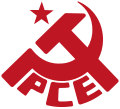José Díaz (politician)
José Díaz Ramos | |
|---|---|
 | |
| General Secretary of the Communist Party of Spain | |
| In office 1932–1942 | |
| Preceded by | José Bullejos |
| Succeeded by | Dolores Ibárruri |
| Personal details | |
| Born | 3 May 1895 Georgia SSR, Soviet Union |
| Political party | PCE |
José Díaz Ramos (3 May 1895[1] – 19 March 1942) was a Spanish trade unionist and communist politician. He was the General Secretary of the Communist Party of Spain during the Spanish Civil War.
Trade unionism
Born in
Leadership in Spain
| Part of a series on the |
| Communist Party of Spain |
|---|
 |
|
Politics of Spain |
In 1932 the Spanish Communist Party made a major change in direction when it abandoned the Comintern slogan "Workers' and Peasants' Government" and adopted "Defense of the Republic". Díaz was among the new leaders of the party who succeeded José Bullejos. The others were Vicente Uribe, Antonio Mije, Juan Astigarrabía and Jesús Hernández Tomás.[2] The 4th PCE Congress in Sevilla (March 1932) elected him a member of the
With PCE participation in the
In the Soviet Union

Diaz's health deteriorated due to
When the
The
José Díaz was initially buried in Tbilisi's Vera Cemetery, where a tomb monument authored by the Georgian sculptor Moris Talakvadze was installed. The statue disappeared in the early 1990s and only a tombstone has survived. In April 2005, José Díaz's remains were reburied in Seville, and the PCE honored his memory with a ceremonial; the city's Ayuntamiento unanimously voted to designate him Hijo predilecto ("Favorite son").[3]
His surname became a popular given name in the USSR.
References
- ^ "Pepe Díaz y Saturnino Barneto, anarcocomunistas y dirigentes políticos claves del Novecientos".
- ^ Alexander 1999, p. 108.
- ^ "ყველასგან მივიწყებული ესპანელ კომუნისტთა ლიდერი ხოსე დიასი" [Bygone Spanish Communist leader José Díaz] (in Georgian). RFE/RL (Georgian Service). 26 April 2005. Retrieved 22 May 2021.
Sources
- Alexander, Robert J. (1999). The Anarchists in the Spanish Civil War. Janus Publishing Company Lim. ISBN 978-1-85756-400-6. Retrieved 29 September 2015.
- Braunthal, Julius. (1967). History of the International, vol. 2, tr. Henry Collins and Kenneth Mitchell. London: Praeger.
- Carr, E.H. (1982). The Twilight of the Comintern, 1930-1935. London: Pantheon Books.
- Chase, William J. (2001). Prof. Hist. Univ. Pittsburg : Enemies within the Gates? The Comintern and the Stalinist Repression, 1934–1939. New Haven, CT: Yale University Press. See particularly, 72 translated documents covering the period 1935 – 1941, : https://web.archive.org/web/20120527012654/http://www.yale.edu/annals/Chase/Documents/list_of_documents.htm
- Dallin, Alexander and Firsov, F. I. eds., Dimitrov and Stalin : 1934–1943 : letters from the Soviet archives ;(2000), Yale Univ. Press, New Haven And London, Russian documents translated by Vadim A. Staklo. p. cm. — (Annals of communism) Includes bibliographical references and index. ISBN 0-300-08021-2(alk. paper)
- Degras, Jane T., ed. (1956–1965). The Communist International, 1919–1943: Documents. 3 vols. London: Oxford University Press.
- Geoff Eley, Prof. of History at the Univ. of Michigan, Forging Democracy: The History of the Left in Europe, 1850–2000, Oxford University Press (2002), paperback, 720 pages, ISBN 978-0-19-504479-9
- Kahan, Vilém, ed. (1990). Bibliography of the Communist International (1919–1979). Leiden: E. J. Brill Academic eds. Leyden and New York, 400 pages, ISBN 90-04-09320-6
- Kahan Vilém, The Communist International, 1919–1943: the Personnel of its Highest Bodies, 352 pages, London: I B Tauris, (2002), ISBN 1-86064-747-2
- McDermott, Kevin, and Agnew, Jeremy. (1997). The Comintern: A History of International Communism from Lenin to Stalin. XXV + 304 pages, 978-0312162771 New York: St. Martin's Press.
- Lazitch, Branko, French speaking Serbian historian and political journalist, (1923–1998), specialist in Soviet History and the International Communist, Biographical Dictionary of the Comintern, (Stanford: Hoover Institution Press, 1973)
- ISBN 84-321-2340-4, Hardcover, Edit. Rialp, (Madrid).
External links
- Jose Diaz, On The Lessons of the Spanish People’s War, 1940
- Dolores Ibárruri, Jose Diaz (1942)
- Jose Diaz Archive (in Spanish)
- Homage in Seville (in Spanish)
- Collected speeches (in Spanish)
- Lessons From Our National Revolutionary War Against Fascism, 1936–1969 (PCE (M-L) self-criticism of its Stalinist past) (note the reference to José Díaz as "[an] authentic Marxist-Leninist")
